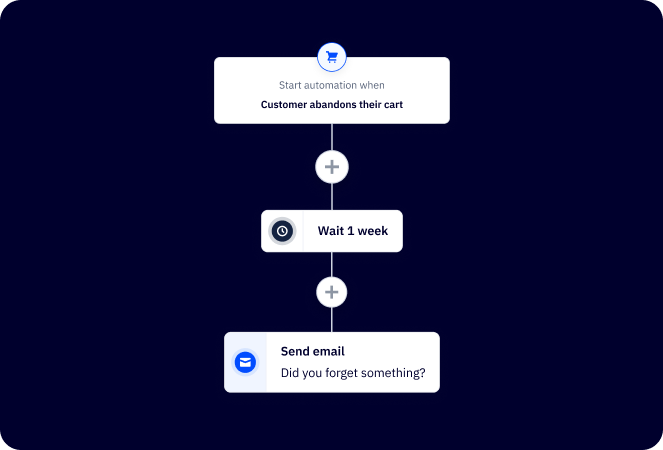Email Service Provider (ESP)
Definition
An email service provider (ESP) is a platform that helps businesses send emails to many people at once. Think of it like a digital post office that handles everything from delivering emails to making sure they don’t end up in spam.
Good ESPs also offer extra features like email templates, contact management, automation, and analytics so businesses can create, send, and track their emails easily. Whether for newsletters, promotions, or automated follow-ups, an ESP ensures emails reach the right people at the right time.
As email marketing has become a more popular marketing channel, more email service providers have sprung up to provide differentiated services. At the most basic level, an ESP needs to do two things: store email addresses and send emails.
Are Gmail, Outlook, and AOL ESPs?
As some of the most popular email-sending services, Gmail, Outlook, and AOL seem like ESPs. While they do help you send emails, they are not what email marketers would refer to as an ESP, as they do not allow you to use email contact lists or send campaigns to subscribers. They are classified as free mailbox providers.
Many people confuse ESPs with free mailbox providers, but the commonly held idea of an ESP is that it is a tool for sending bulk emails. Free mailbox providers allow you to send large emails. However, there is typically a limit, and you can't track email performance, something a standard ESP like HubSpot or ActiveCampaign offers.
While both provide email communication, they cater to different needs. Here’s a quick overview of their differences:
• Purpose: ESPs are designed for email marketing, allowing users to send bulk emails to subscribers, while free mailbox providers focus on personal communication.
• Volume limits: ESPs can handle thousands or millions of emails at once; free providers typically limit daily sends to a few hundred.
• Features: ESPs offer advanced tools for analytics, list management, and email design; free providers provide basic functionalities without marketing features.
• Target audience: ESPs cater to businesses and marketers; free mailbox providers are intended for individual users.
Understanding these distinctions can help you choose the right service for your email needs.
What an advanced email service provider can do for you
A solid ESP is more than just a tool for sending emails. It’s a powerhouse for automating, personalizing, and optimizing your marketing efforts. If you're only using your ESP to send newsletters or basic campaigns, you're missing out on a ton of features that can take your email marketing to the next level.
Here’s a deep dive into what an advanced ESP brings to the table:
Lead capture forms
Before you can start sending emails, you need people to send them to. That’s where lead capture forms come in. These forms help you collect email addresses directly from your website, landing pages, or pop-ups—turning visitors into subscribers.
With an advanced ESP, you’re not stuck with generic-looking forms. You can customize the design, fields, and placement so they fit seamlessly into your brand. But the real magic happens after someone signs up. Instead of just adding them to your email list, a good ESP can automatically trigger welcome emails, kick off an onboarding sequence, or even segment new leads based on their interests from the start.
Automation and triggers
Automation is where an ESP goes from being just a sending tool to a full-on marketing assistant. Instead of manually sending emails, you can set up automations that trigger based on specific actions your subscribers take.
For example:
- Someone signs up for your newsletter? — They instantly get a welcome series.
- A customer abandons their cart — They receive a reminder email with a discount.
- A subscriber clicks on a link about a particular product — They get follow-up content tailored to their interest.
And it’s not just simple “if this, then that” automation. Advanced ESPs allow for multi-step workflows, where subscribers move through different sequences depending on how they interact with your emails.

With conditional logic, you can ensure subscribers get the most relevant content based on their behavior, whether they’re opening emails, clicking links, or making purchases.
A/B testing (even for entire automations)
Most ESPs let you A/B test subject lines or email content, but an advanced ESP takes it further.
You can test:
- Subject lines to see which one gets the most opens.
- Email content to determine which message drives more clicks.
- Send times to find out when your audience is most engaged.
- Entire automation workflows to see which path leads to the best results.
For example, if you have a post-purchase follow-up sequence, you can test different versions—one that offers a discount for a future purchase vs. one that simply thanks the customer. Over time, you’ll learn what works best and can continuously optimize your email strategy.
Smart segmentation
Sending the same email to everyone on your list is outdated. Advanced ESPs allow for dynamic segmentation, meaning you can group subscribers based on their behavior, preferences, and past interactions.
Instead of creating static lists, smart segments update automatically as subscribers take actions. For instance:
- If someone clicks on an email about running shoes, they move into a segment interested in fitness products.
- If a customer hasn’t opened an email in three months, they get tagged as inactive, and you can send a re-engagement campaign.
- If someone makes a purchase, they get moved into a VIP customer segment for exclusive offers.
The more personalized your emails are, the more likely they are to get opened and acted on. This makes segmentation one of the most powerful tools in your ESP’s arsenal.
Advanced analytics
To improve your email marketing, you need to know what’s working (and what’s not). Advanced ESPs offer deep analytics beyond just open and click rates.
Some of the insights you can track include:
- Engagement trends: See how subscriber behavior changes over time.
- Heatmaps: Find out which links get the most clicks within your emails.
- Conversion tracking: Connect emails to actual revenue by seeing how many subscribers made a purchase after clicking.
- Customer journey tracking: Understand how subscribers move through your automations and where they drop off.
Having access to this level of detail allows you to tweak your strategy and continuously improve your campaigns.
List management tools
A healthy email list is key to good deliverability, and advanced ESPs include list management features to keep things clean and organized.
Instead of manually sorting through contacts, your ESP can:
- Tag and categorize subscribers based on their activity.
- Automatically remove inactive subscribers to keep your list fresh.
- Keep track of bounced emails and invalid addresses to maintain a good sender reputation.
Good list hygiene ensures you’re only sending emails to people who actually want them, improving engagement rates and reducing the risk of landing in spam folders.
Behavior-based email personalization
Personalization goes beyond just adding someone’s first name to an email. Advanced ESPs use behavioral data to customize content for each subscriber.
For example:
- If a subscriber frequently browses a specific category on your website, they receive product recommendations based on what they like.
- If they abandon their cart, they get an email reminding them about their items (maybe even with a discount).
- If they’re a long-time customer, they get loyalty offers instead of generic promotions.
With dynamic content blocks, different sections of an email can change based on the recipient, ensuring every subscriber gets an email that feels tailor-made for them.
SMS and multi-channel messaging
Email isn’t the only way to reach your audience. Many advanced ESPs now include SMS, push notifications, and even social media messaging as part of their automation features.
For example:
- A subscriber gets an email about a sale, followed by a reminder SMS if they don’t open it.
- A cart abandonment sequence includes both an email and a text message with a time-sensitive discount.
- A webinar signup confirmation is sent via email, with a reminder text an hour before the event.
By combining multiple channels, you increase the chances of getting your message seen and acted on.
E-commerce integrations
An ESP that integrates seamlessly with your e-commerce platform is a must for online stores. Advanced ESPs connect with Shopify, WooCommerce, Magento, and other platforms to automate sales-driven emails.
Key features include:
- Abandoned cart recovery: Automatically remind customers to complete their purchase.
- Post-purchase follow-ups: Send thank-you emails, request reviews, or suggest related products.
- Personalized product recommendations: Use past purchase data to suggest items a customer might like.
- Revenue tracking: See exactly how much money each email campaign generates.
If your ESP isn’t tightly integrated with your e-commerce platform, you’re missing out on major revenue opportunities.
Deliverability and sending optimization
Even the best-designed emails are useless if they never reach the inbox. Advanced ESPs come with deliverability tools to ensure your emails pass spam filters.
Key features include:
- Send-time optimization: Emails are sent at the exact time your audience is most likely to open them.
- Dedicated IPs: Helps establish a strong sender reputation for businesses that send high volumes.
- Spam score checking: Identifies potential red flags before you hit send.
A good ESP doesn’t just send emails, it makes sure they actually land where they’re supposed to.
If you’re still just sending newsletters and one-off campaigns, it might be time to explore what an advanced ESP can do for your business. A more advanced ESP takes a lot of the guesswork out of email marketing. Instead of just sending emails, you get tools to automate, personalize, and analyze your campaigns—helping you engage your audience and drive better results.
Choosing the right ESP for you
Choosing the right ESP is a big deal. It can make or break how effectively you connect with your audience. With so many options out there, you need to find a tool that fits your business’s specific needs, whether you’re sending bulk email campaigns, automating follow-ups, or handling transactional emails.
What to look for in an ESP
Different businesses need different things from an ESP, so it helps to think about what you do daily. Here are some key factors to consider:
• Email marketing capabilities: Can it handle bulk email campaigns, automated sequences, and transactional emails (like order confirmations or password resets)?
• Ease of use: Is the platform user-friendly, or will sending a campaign require hours of tutorials?
• Automation and personalization: Can you send emails based on customer behavior, like abandoned carts or website visits?
• Segmentation and targeting: Can you send different emails to different types of customers based on their interests?
• Analytics and reporting: Does it give you deep insights into open rates, click-through rates, and conversions?
• Integrations: Will it play nicely with your existing marketing and sales tools (like your CRM, e-commerce platform, or analytics software)?
Why integrations matter
A great ESP isn’t just a standalone tool; it should fit into your existing marketing and sales stack. The right platform will help you do a couple of different things:
- Sync contacts and data across tools, avoiding messy imports and exports.
- Automate emails based on CRM activity, e-commerce sales, or other triggers.
- Track customer interactions in one place for better personalization.
Why data protection matters in an ESP
Email marketing isn’t just about sending great campaigns, it’s also about keeping customer data safe. A good ESP should comply with data protection regulations like GDPR (Europe), CCPA (California), and CAN-SPAM (U.S.) to ensure your emails are legal and your subscribers' information is secure.
Data protection to look for in an ESP:
✅ Compliance with major regulations: Make sure the ESP follows GDPR, CCPA, and other relevant laws to avoid fines and legal trouble.
✅ Data encryption and security: Look for features like two-factor authentication and encrypted data storage.
✅ Subscriber consent tools: The ESP should allow for easy opt-ins, preference management, and unsubscribe options.
✅ Data processing agreements (DPAs): Some ESPs provide DPAs outlining how they handle and protect customer data.
✅ Reliable email deliverability: Compliance with anti-spam laws ensures your emails don’t get flagged or blacklisted.
Choosing an ESP that takes data protection seriously helps you build trust with your audience while keeping your business safe from compliance issues.
Top five email service providers
Now, let’s look at some of the best ESPs available today and what makes them a good fit for different kinds and sizes of businesses.

HubSpot – Best for all-in-one marketing and sales
Why it’s great:
- Combines email marketing, CRM, and automation in one platform.
- Drag-and-drop email builder with pre-designed templates.
- Built-in CRM makes it easy to track customer interactions.
- Advanced segmentation and personalization options.
- Strong reporting tools, but it can get pricey for growing businesses.

ActiveCampaign – Best for advanced automation and personalization
Why it’s great:
- Powerful automation features let you send emails based on user behavior, site visits, and CRM activity.
- Advanced segmentation ensures the right message goes to the right person.
- A/B testing for subject lines, content, and even full automation workflows.
- Deep integration options with e-commerce, CRM, and other tools.
- More affordable than some competitors for the level of automation it offers.

Mailchimp – Best for beginners and small businesses
Why it’s great:
- Super easy to use with drag-and-drop email creation.
- Built-in audience segmentation and basic automation tools.
- Free plan available, making it great for startups and small businesses.
- Integrates with a ton of third-party apps.
- Not as strong in automation compared to ActiveCampaign or HubSpot.

Klaviyo – Best for e-commerce businesses
Why it’s great:
- Designed specifically for online stores (works great with Shopify, WooCommerce, Magento).
- Advanced segmentation and predictive analytics for personalized emails.
- Revenue tracking directly tied to email campaigns.
- Strong abandoned cart and product recommendation features.
- Can be pricey, but worth it for e-commerce brands focused on growth.

SendGrid – Best for developers and transactional emails
Why it’s great:
- Focuses on reliable email delivery (great for transactional emails like order confirmations).
- Scalable API for businesses that need more control over sending.
- Strong deliverability tools to help avoid spam filters.
- Can handle marketing emails but lacks advanced automation features.
It's up to you
There’s no one-size-fits-all ESP. The best one for you depends on your needs:
- Need an all-in-one marketing and sales solution? HubSpot
- Want advanced automation and deep personalization? ActiveCampaign
- Looking for something easy and budget-friendly? Mailchimp
- Running an e-commerce store? Klaviyo
- Sending a lot of transactional emails? SendGrid
Before committing, take a moment to map out what your business needs from an ESP. The right choice can seriously boost your marketing game.
Keep reading:
• The 7 Best Mass Email Software Services
• See how ActiveCampaign and HubSpot stack up
• Venture Harbour tests and finds the best email marketing services